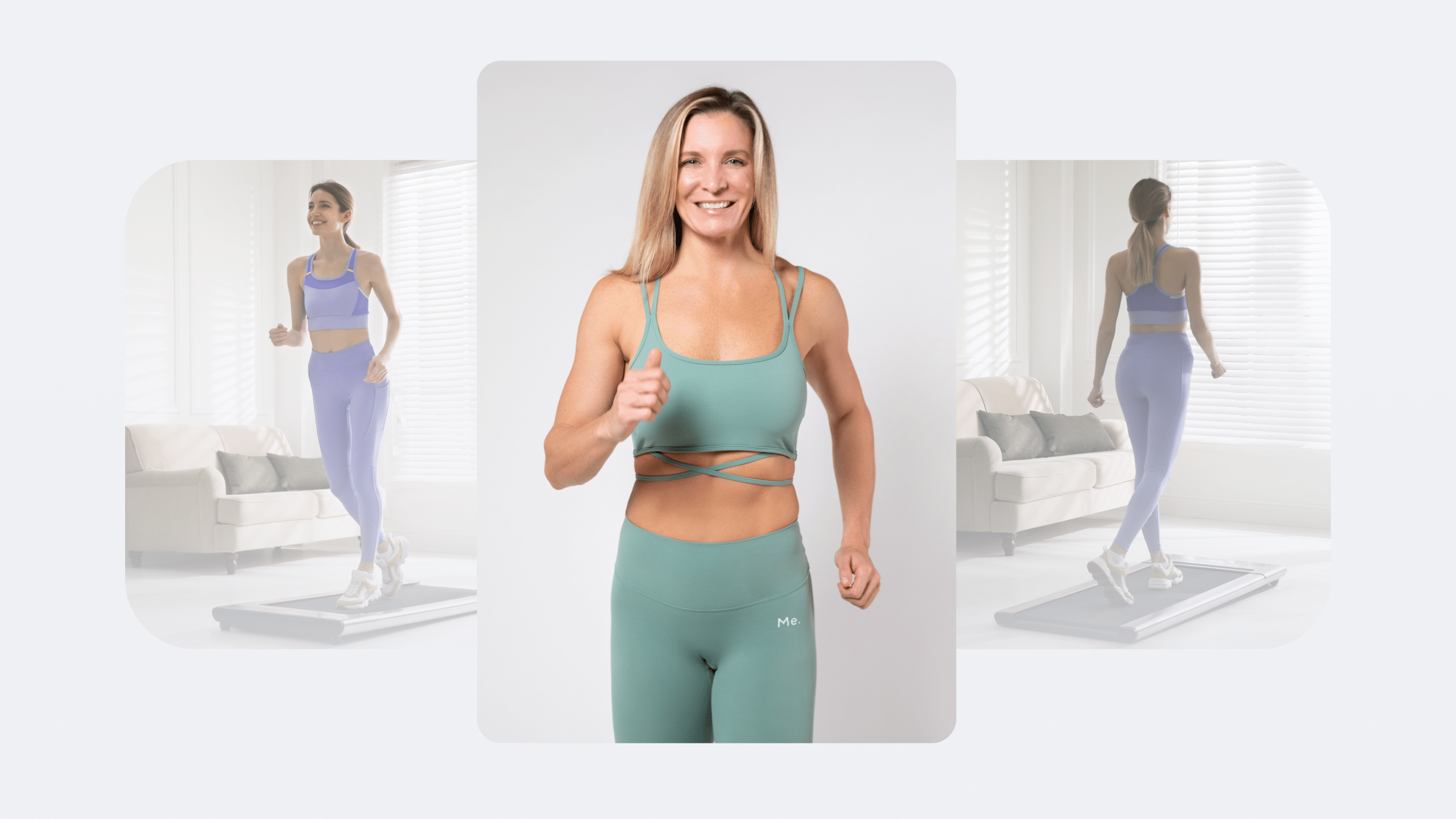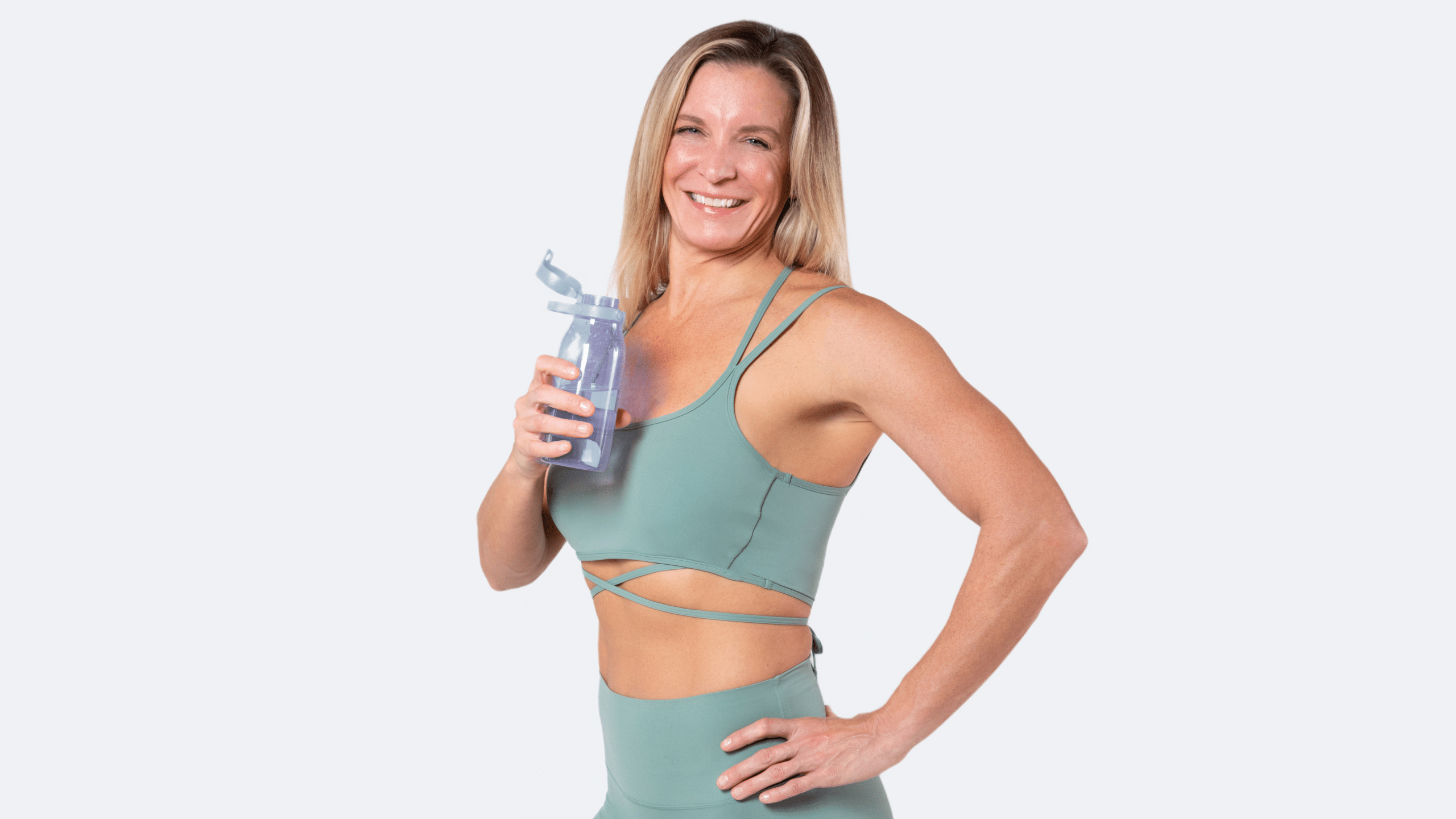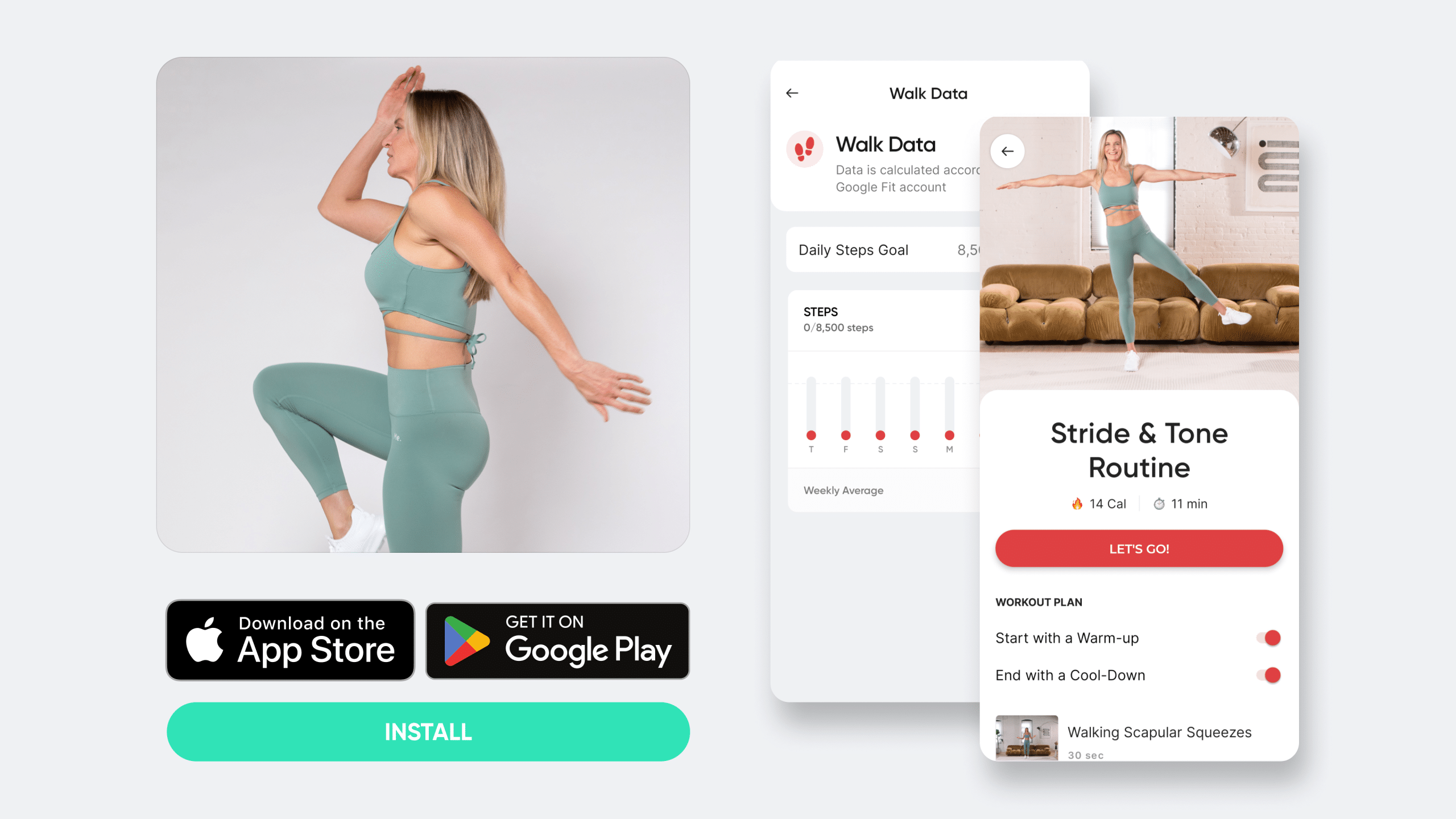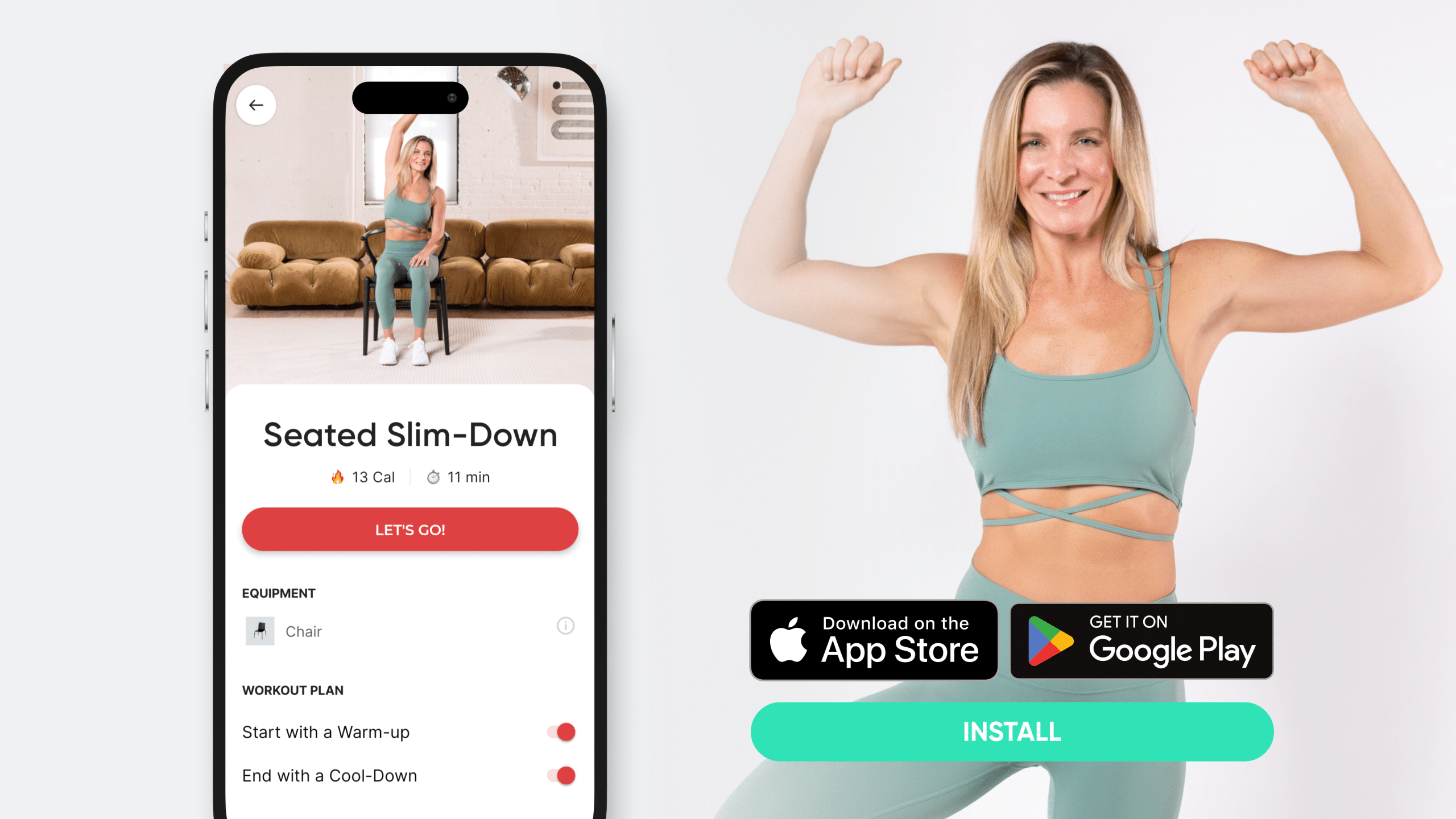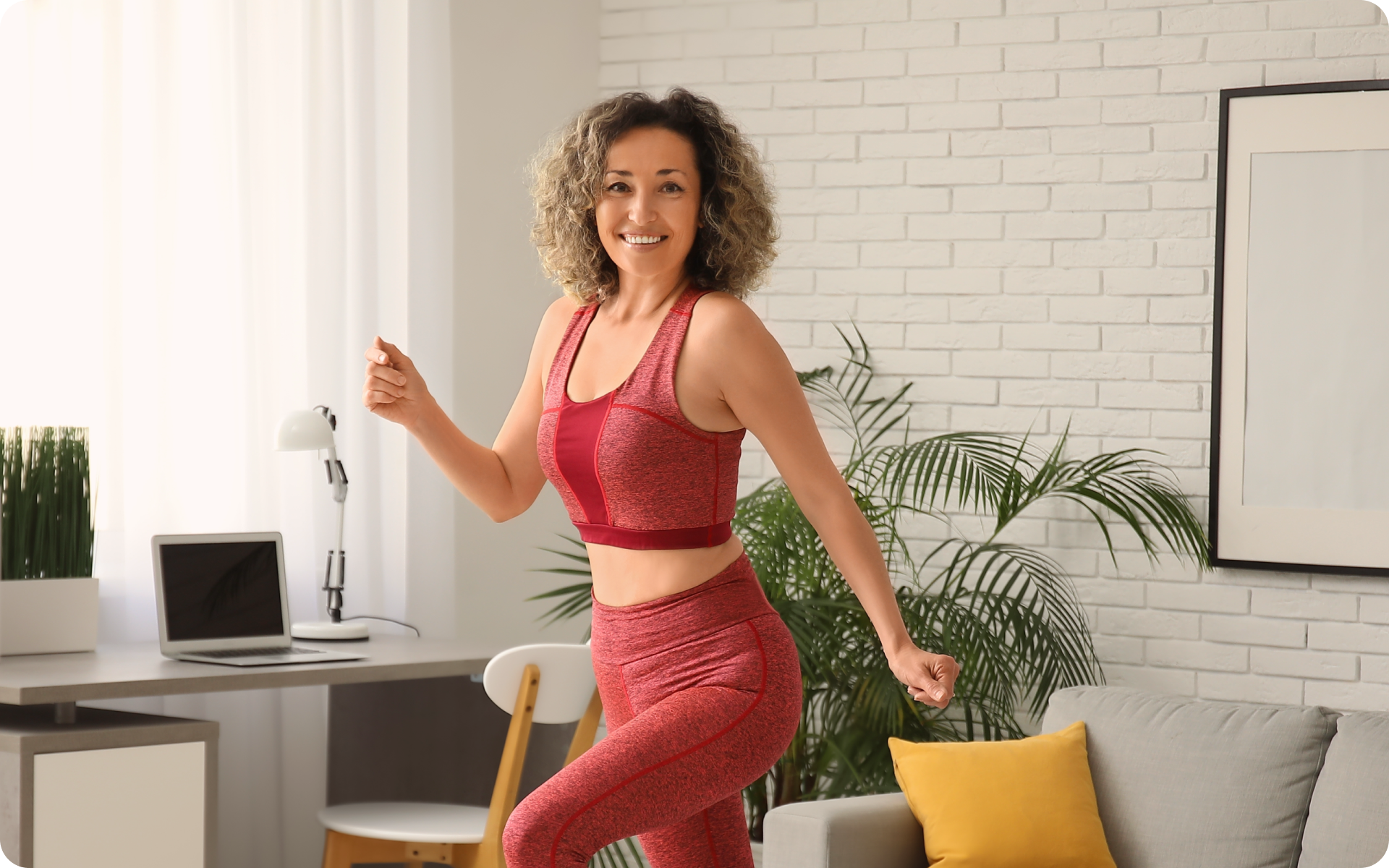Getting on track with a fitness routine can be challenging, especially when you have a hectic schedule, limited gym access, or even just a general aversion to stepping out the door for a workout. It seems like these factors would derail your fitness journey, but indoor workouts are actually a fantastic solution.
Depending on how much space you have available at home, there are many exercises that can be adapted to fit within your living room, bedroom, or even a small home office. You can even use some everyday household items as fitness equipment!
In this guide we’ll explore everything you need to know about making the most out of your indoor exercise routines, providing you with effective workouts that can be done within the comfort of your own home.
What Exercises Can Be Done At Home?
Any exercise that doesn’t require heavy-duty equipment or a large space can be easily done at home. While there’s no single “best indoor exercise”, you may find that some types of exercises suit your personal goals and preferences better than others. Here are a few examples of indoor exercises that require minimal space and equipment:
Bodyweight Exercises for Strength
These exercises use your own body weight as resistance to build strength, and can easily be done at home (5). These are on top of our list of indoor exercises that don’t need equipment, simply because they can be very effective.
They’re also ideal as indoor exercise for beginners, who need to focus on mastering the basics and building a foundation before adding weights or equipment.
Some popular bodyweight exercises include push-ups, lunges, squats, planks, and mountain climbers.
Dropping pounds by the dozens without putting yourself through the wringer is everyone’s weight loss pipe dream. But what if we told you that the BetterMe app can make that happen? Keep yourself in prime shape with our fat-blasting workouts, delicious budget-sparing recipes, and body-transforming challenges with our app!
Here’s a sample 3 day indoor exercise routine for at-home bodyweight exercises:
Day 1: Lower Body
- Bodyweight Squats: 3 sets of 10-15 reps. Start with feet hip-shoulder width apart, keep your chest up, push your hips back, and bend your knees to lower into a squat. Stand back up and repeat.
- Lunges: 3 sets of 10 reps each leg. Start by standing tall with feet shoulder-width apart, step forward with one foot, and lower your body until your front knee is at a 90-degree angle. Push back up to the starting position and switch legs.
- Glute Bridges: 3 sets of 15 reps. Lie on your back with knees bent and feet flat on the ground. Initiate the movement by pushing through your heels and raise your hips off the floor until your knees, hips, and shoulders form a straight line.
- Step-ups: 3 sets of 10 reps each leg. Using a sturdy chair or step, step one foot onto the step, press down through your whole food and push your body up onto the step. Lower back down and repeat with the other leg.
- Wall Sit: 3 sets of 30-60 seconds. Stand with your back against a wall, slide down until your thighs are parallel to the floor and hold.
- Calf Raises: 3 sets of 15 reps. Stand tall and push through the balls of both feet to raise your body upward. Lower back down to complete one rep.
Day 2: Upper Body
- Push-ups: 3 sets of 8-12 reps. Start in a high plank position, lower your body until your chest touches the floor. Push your body up back to the starting position.
- Tricep dips: 3 sets of 8-12 reps. Sit on the edge of a chair, slide your butt off the chair, and lower your body by bending at the elbows. Push back up to start.
- Plank: 3 sets of 30-60 seconds. Get into a push-up position but rest your weight on your forearms instead of your hands. Keep your body straight and hold.
- Mountain climbers: 3 sets of 15 reps each leg. Start in a high plank position, bring your right knee towards your chest, then switch and bring the left knee towards the chest.
- Arm Circles: 3 sets of 15 reps. Stand with your feet shoulder-width apart and extend your arms out to the sides. Rotate your arms in small circles.
- Inchworms: 3 sets of 8-10 reps. Stand tall, bend forward and touch your toes. Walk your hands forward to come into a high plank position, then walk your hands back towards your feet and stand up.
Day 3: Full Body
- Burpees: 3 sets of 8-12 reps. Start standing, lower into a squat, kick feet back to come into a high plank, lower chest to floor, push up into a high plank, jump feet in towards hands, and jump up into the air.
- Squat Jumps: 3 sets of 10-15 reps. Perform a regular squat, but as you stand up, use your lower body to jump up. Make sure to land with control.
- High Knees: 3 sets of 30 seconds. Start standing and quickly drive one knee at a time up towards your chest, as if running on the spot.
- Jumping Jacks: 3 sets of 15-20 reps. Stand with your feet together and hands at your sides, jump your feet apart and bring your arms above your head, then jump back to the starting position.
- Bear Crawls: 3 sets of 30-60 seconds. Get on all fours with your shoulders positioned over your wrists and knees positioned directly under your hips. Raise your knees slightly off the ground. Move forward using your hands and feet.
- Lying Leg Raises: 3 sets of 10-15 reps. Lie flat on your back with your legs straight. Lift both legs up to the ceiling until your butt comes off the floor, then lower them back down without letting your lower back lose its contact with the floor.
Chair Yoga for Flexibility
Yoga is great for flexibility and toning, but you may not have enough space for extensive poses. Chair yoga is a fantastic option for indoor exercise that can easily be done in small spaces. We recommend these as indoor exercise activities for adults who prefer low-impact workouts or have mobility limitations (1).
Our blog on Low-Intensity Workouts details more information on effective low-impact exercises.
Morning/Evening Walks for Cardio
Walking is a great form of cardio, and it’s one of the best indoor exercises for seniors. Just because you can’t leave your home doesn’t mean you have to skip out on this beneficial activity. You can easily get in some steps by taking a walk around your house or walking up and down the stairs. If you have a treadmill at home, that’s an excellent option for indoor cardio as well.
Research has shown that Low-Intensity Steady State (LISS) cardio, such as walking, can be just as effective as high-intensity workouts for cardiovascular health and weight loss. This makes it an ideal indoor exercise option for those who may not be able to handle intense workouts or are looking for a more sustainable form of exercise (4).
Read more: Bubble Butt Workout 101: Achieve Your Booty Goals with These Proven Exercises
Jump Rope HIIT Workouts
High-Intensity Interval Training (HIIT) is an efficient way to burn calories and improve cardiovascular health. It’s actually one of the best indoor exercises for weight loss (3). And with just a jump rope you can easily create a HIIT workout at home.
Jumping rope for short bursts of intense activity, followed by brief periods of rest, is a great way to get your heart rate up and improve overall fitness.
Check out our blog on Indoor Activities for Kids for more indoor exercise ideas that are fun and family-friendly.
Why Are Indoor Exercises More Popular?
Indoor exercise at home is popular because it’s convenient, affordable, and can be done in any weather. Having the option to work out indoors means:
You can work out at any time – you know the way you sometimes put off going to the gym because it’s too early, or too late, or because you’re just not in the mood? With indoor exercise at home, you can skip the excuses and work out whenever it works for you. Whether that’s the first thing in the morning or right before bed.
No equipment, no problem – Not everyone has a gym membership, nor does everyone have the space or budget for a home gym.
The great thing about indoor exercise at home is that you don’t need any equipment to get started. Your body weight and some creative thinking can be all you need for an effective workout.
Weather-proof – Let’s face it, going to the gym just doesn’t seem as appealing when it’s pouring rain or snowing outside.
With indoor exercise, you never have to worry about the weather getting in the way of your workout routine. You can stay safe and dry while still getting your sweat on.
Can You Lose Weight With Indoor Exercise?
Yes, you can lose weight with indoor exercise. Just like any other form of exercise, burning calories and losing weight with indoor workouts is all about intensity (how hard you work) and duration (how long you work).
By following a consistent workout routine that challenges your body and elevates your heart rate, combined with healthy eating habits, you can achieve weight loss goals through indoor exercise.
The best indoor exercise for weight loss is the one that you’ll stick with and enjoy doing. This could be high-intensity interval training (HIIT), bodyweight resistance exercises, or even taking a dance class online!
The key is to find a routine that suits your fitness level and interests so you can stay motivated and committed to reaching your weight loss goals.
Other Benefits of Indoor Exercise
Apart from being convenient and adaptable to any space or budget, there are other benefits to incorporating indoor exercises into your fitness routine. These include:
Improved cardiovascular health – Many indoor exercises such as jumping jacks, burpees, and high knees can get your heart pumping and improve cardiovascular health. By regularly incorporating these exercises into your routine, you can reduce the risk of heart disease and other cardiovascular issues (5).
Increased muscle strength – Bodyweight exercises like push-ups, squats, and lunges help to build muscle strength, without the need for any equipment (5). This is especially beneficial for those who may not have access to weights or resistance bands at home.
Better flexibility and balance – Indoor exercises such as yoga, Pilates, and stretching routines can improve flexibility and balance. This is particularly useful for those who sit at a desk all day or have a sedentary lifestyle (1).
Stress relief – Exercise has been proven to help reduce stress levels by promoting the release of endorphins, also known as the “feel-good” hormones. Indoor exercises are a great way to incorporate physical activity into your daily routine and help manage stress levels (2).
Our blog on Benefits of Indoor Cycling illustrates just how effective indoor exercises can be for both physical and mental well-being.
Want to build an attention-grabbing bubble butt, blast away fat that’s stored in all the wrong places, spring-clean your diet, turn back the clock on your skin, skyrocket your self-confidence and shatter your insecurities? Check out the BetterMe app and set this plan in motion!
Why Indoor Gym Is Better Than Outdoor?
Indoor gym workouts do have some advantages over outdoor workouts, and these include:
More variety – Gyms usually offer a wide range of equipment and classes that you can’t necessarily replicate in an outdoor setting. This provides more options for exercising different muscle groups and even trying out new exercises.
Better safety – With equipment like weights and machines, indoor gyms allow for safer handling and use compared to outdoor workouts. In addition, gym staff are trained in safety procedures and can assist if needed.
Year-round consistency – With indoor gyms, you can maintain a consistent workout routine regardless of the season or weather conditions. This is especially beneficial for those who live in areas with extreme climates.
Protection from environmental factors – Outdoor workouts can expose you to elements like pollution, extreme temperatures, and even bugs. With indoor exercise, you can avoid these potential health hazards and focus on your workout instead.
How Can I Exercise At Home Easily?
You can exercise at home easily by; making some space in your home, finding or creating an exercise routine that works for you, and setting achievable goals to keep yourself motivated. Here are some tips on how you can get started:
Clear out a workout space – Find an area in your home where you have enough room to move around freely without any obstructions. This could be a spare room, living room, or even your backyard.
Use household items as equipment – Get creative and use household items like water bottles, towels, or even a sturdy chair for resistance training exercises.
Try indoor exercises without equipment – Bodyweight exercises are a great way to get started with indoor workouts. Push-ups, planks, and squats are just some of the many exercises that can be done without any equipment.
Find online fitness resources for indoor exercise ideas – There are plenty of free workout videos and tutorials available online that you can follow along with at home. You can also find apps that offer personalized exercise plans based on your fitness level and goals.
Set realistic goals – It’s important to set achievable goals for yourself, whether it’s increasing the number of reps or trying out a new exercise every week. This will help you stay motivated and track your progress over time.
Keep showing up – Even if you can only spare 10-15 minutes a day, make sure to keep showing up and putting in the effort. Every little bit counts towards your overall progress.
Read more: 4 Best Core Exercises for Beginners: 16 Core Workouts for Men, Women, and Seniors
FAQs
What Workout Should I Do Everyday at Home?
A balanced home workout should include cardiovascular exercises such as dynamic movements like jumping jacks or high knees or lower impact movements like walking, strength-building exercises like push-ups or squats, and flexibility exercises such as yoga or stretching. Remember to start slowly if you are a beginner, and gradually increase the intensity and duration of your workouts.
Is Working Out 30 Minutes a Day Enough to Lose Weight?
Yes, working out for 30 minutes a day can help you lose weight, especially when combined with a healthy diet. High-intensity interval training (HIIT) can be particularly effective because it burns a lot of calories in a short period of time (3).
What Is a Cheap Exercise Fun?
Walking or jogging in your local park, doing a dance workout at home, or playing a sport with friends are all fun, low-cost ways to exercise. The key is to find an activity that you enjoy so that working out doesn’t feel like a chore.
How Much Exercise Do I Need Per Day?
The World Health Organization recommends at least 150 minutes of moderate-intensity exercise or 75 minutes of vigorous-intensity exercise per week for adults. That breaks down to about 20 to 30 minutes of exercise per day.
Does Running on a Treadmill Build Muscle?
Running on a treadmill predominantly works your cardiovascular system and helps you burn calories. However, it also engages your leg and core muscles, which can help lead to increased strength and muscle definition over time when combined with regular resistance training. To enhance muscle building on the treadmill, incorporate incline or resistance into your workouts.
The Bottom Line
Indoor exercise provides a convenient, affordable, and safe way to stay active and healthy without having to leave the comfort of your own home. Whether you prefer bodyweight exercises or using equipment in a gym setting, there are many options available to fit any fitness level or goal.
With the added benefits of improved cardiovascular health, increased muscle strength and flexibility, and stress relief, it’s clear that incorporating indoor exercise into your routine can have a positive impact on your overall well-being.
DISCLAIMER:
This article is intended for general informational purposes only and does not serve to address individual circumstances. It is not a substitute for professional advice or help and should not be relied on for making any kind of decision-making. Any action taken as a direct or indirect result of the information in this article is entirely at your own risk and is your sole responsibility.
BetterMe, its content staff, and its medical advisors accept no responsibility for inaccuracies, errors, misstatements, inconsistencies, or omissions and specifically disclaim any liability, loss or risk, personal, professional or otherwise, which may be incurred as a consequence, directly or indirectly, of the use and/or application of any content.
You should always seek the advice of your physician or other qualified health provider with any questions you may have regarding a medical condition or your specific situation. Never disregard professional medical advice or delay seeking it because of BetterMe content. If you suspect or think you may have a medical emergency, call your doctor.
SOURCES:
- Effect of Chair Yoga Therapy on Functional Fitness and Daily Life Activities among Older Female Adults with Knee Osteoarthritis in Taiwan: A Quasi-Experimental Study (2023,nih.gov)
- Exercise and stress: Get moving to manage stress (2022,mayoclinic.org)
- High-intensity interval training for health benefits and care of cardiac diseases – The key to an efficient exercise protocol (2019,nih.gov)
- Slow and Steady, or Hard and Fast? A Systematic Review and Meta-Analysis of Studies Comparing Body Composition Changes between Interval Training and Moderate Intensity Continuous Training (2021,nih.gov)
- The advantages of body-weight exercise (2022,nih.gov)

